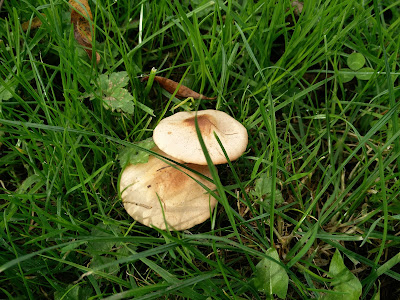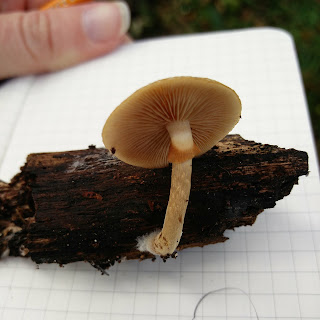I'm not used to this level of gadding-about and hob-nobbing so by the time I got home on Saturday evening my brain was buzzing. I normally try and keep some separation between my work as a local environmental record centre manager at Sussex Biodiversity Record Centre and the fungus recording which I do as a hobby; so the mycology doesn't start to feel like 'work'. But on this occasion they all got tangled up together.
This blog is an attempt at turning that tangle into something vaguely coherent.
I noticed a few weeks back that the British Mycological Society (BMS) had become a member of the National Biodiversity Network (NBN).
This struck me as a very positive development, as the NBN includes lots of different organisations, schemes and societies with an interest in biological data. And I'm all for working together.Delighted @BritMycolSoc now members of the Network. Thanks for your support! Find out more at https://t.co/x9zxDgD0kT #partnershipfornature pic.twitter.com/8zuhwmjdqk— NBN Trust (@NBNTrust) October 10, 2017
One theme that often comes up in NBN conference talks is how to get more and better biological data; and make it accessible so it can be used. On this topic, Sue Townsend gave a short update on the Field Studies Council's exciting new BioLinks project which has been awarded Heritage Lottery funding to support communities of volunteers in developing biological recording skills. The project will focus particularly on difficult and under-represented taxa and helping people to access the mentoring and resources that are needed to build expertise and confidence in recording these groups.
During the consultation phase for the BioLinks project (which was managed very effectively by Keiron Derek Brown) I did my best to make a play for fungi being one of the 'difficult and under-represented taxa' that the project might focus on. But it seems the invertebrates got the most votes in the end. Still, I'm sure many of the BioLinks principles and ideas are transferrable so I'd urge folk interested in this kind of thing to take a look at the consultation report and development plan for training provision which the folk at FSC have been kind enough to share.
Listening to the talks at the BMS Open Autumn Meeting on the Saturday, it struck me that the challenges with recording fungi are on a different scale to many other taxon groups. Not least because there is still so much work to do on taxonomy.
I'm not the first person to think this: Caroline Hobart, in her talk, referenced a report from the House of Lords Science and Technology Committee which concluded that, "the state of systematics and taxonomy in the UK, both in terms of the professional taxonomic community and volunteers, is unsatisfactory – in some areas, such as mycology, to the point of crisis." Gosh.
After being rather scared off the Cortinarius last year (which I talked about here), I was very interested to hear Dr. Jorinde Nuytinck explain the work she's been doing on the European Milkcaps (Lactarius and Lactifluus species): looking at the extent to which species grouped according to their morphological characters ('morpho-species') match up with phylogenetic species concepts (i.e. an understanding of whether species are descended from a common ancestor, based on DNA analysis).
As is the case with most fungus talks I go to these days, this resulted in me discovering that the one Milkcap I thought I knew, the Ugly Milkcap Lactarius turpis is not what I thought it was: the recommended name is now Lactarius necator. And I think Dr. Nuytinck said something about it being cryptic, along with Lactarius sordidus (?), i.e. these two species are, according to our current understanding, morphologically identical but phylogenetically distinct. Like a 'brother from another mother'?
DNA barcoding sounds like it's not at all straight forward and can lead you up the garden path if you're not careful (and there was me imagining it to be some kind of magic answer machine). So it was good to hear Dr. Nuytinck explain the different techniques she's used to ensure she is drawing the correct inferences about species' relatedness and phylogeny.
Overall the work of earlier taxonomists seems to have stood up remarkably well to scrutiny as Dr. Nuytinck explained that 75 % of the previously-named European Milkcap species are phylogenetic species. I guess there's still some sorting out to do on the remaining 25 %.
Later on that morning Prof. Henry Beker gave us an update on the Hebeloma. And I think the short summary of that talk would be... these are DONE! After decades of research, Prof. Beker and his colleagues have now sorted out the phylogenetic species of Hebeloma and, through pain-staking observation and databasing, found morphological features which can be used to separate the various species. This work has been published in the latest issue of Field Mycology which landed on my doormat a few days ago, in an article on 'Hebeloma in the United Kingdom', and also in a new volume of Fungi Europaei. So perhaps it's time to have a proper go at Hebeloma...
Caroline Hobart, an amateur mycologist and Chair of the BMS Field Mycology and Conservation committee, gave a fascinating presentation on her journey into myco-science and the work she's been doing on underground ('hypogeous') fungi: the Truffles etc. Caroline Hobart's article in the latest issue of Field Mycology on 'Elaphomyces asperulus Vittad. a forty year British issue resolved' gives some insight into the type of work she's been doing, studying British and European material and collaborating with a number of professional mycologists. One of the points she makes, which I found very inspiring, is that amateurs can make a significant contribution to our collective understanding of fungal ecology and systematics – if we are supported in developing the right skills and gaining access to the necessary tools and resources.
This got me back to thinking about the various initiatives which had been talked about at the NBN conference and whether any of those might be transferable to the field of mycology – to help address the challenges Caroline Hobart had highlighted.
The conference had started with a keynote presentation by Prof. Simon Leather on 'Why I Joined the Twitterati', basically explaining how he uses social media to take entomology to a wider audience.
Now, I probably spend too much time dicking about on Twitter. But I do think it's a great tool for science communication: the ornithologists and the entomologists are all over it. You have to work quite hard to find the mycologists – but they're there! And you can get some interesting insights into the work they're doing, if you manage to find them.
The folks involved in the Lost & Found Fungi project (@LostFoundFungi) have helped me a lot with learning the mycological ropes and I really enjoyed seeing what the mycologists from Kew (@KewMycology) got up to on their recent field trip to Colombia, via the #BoyacáFungi hashtag.
Morgan Jackson (@BioInFocus) is an interesting account to watch when it comes to doing biodiversity and taxonomy outreach on Twitter. He made this great spreadsheet listing entomological experts on Twitter. I want one for mycologists! (If I say it often enough, maybe someone will make one...)
While I'm on this subject, I should mention that the British Mycological Society does have an excellent and very active Facebook page which is a great source of ID advice.
I'm not saying that Twitter can solve mycology's problems – but there are people out there demonstrating that it's a great tool for connecting professionals and amateurs, in constructive ways. And, as an amateur, I'd love to see more of that kind of thing. Because meetings at Kew are great but they only come around once a year: I want to hear about all the cool science people are working on in between. And maybe, if I knew what they were doing, I could contribute something useful (like collections of particular species).
The other talk at the NBN conference which I felt could have some relevance was the presentation by Steph West and John Tweddle from the Angela Marmont Centre (AMC) for UK Biodiversity at the Natural History Museum on 'Bridging the skills gap in UK species identification'. Their 'ID Trainers' project, funded by the Heritage Lottery Skills for the Future programme, has focussed on pro-actively supporting the UK's taxonomic skill-base. As this project is coming to an end, John Tweddle explained that they are now in the process of formulating their new 5-year AMC and UK biodiversity training strategies and are keen to ensure these benefit the sector as widely as possible. So perhaps now would be a good time for a chat about how fungi could feature in that...
Another strand to the discussions at the BMS Open Autumn Meeting was fungal conservation. Marcus Yeo, Chief Executive of JNCC and a field mycologist himself, gave a fairly sobering presentation on this subject. But he ended with some positive thoughts on strategies for effective fungal conservation:
This got me thinking about the keynote presentation on the second day of the NBN conference: Dr Mark Eaton, Principal Conservation Scientist at the RSPB, talking about 'The State of Nature: past, present and future'.
The State of Nature is a report produced by the RSPB, bringing together data from a partnership of over 50 organisations and it's been a powerful tool for raising the profile of nature conservation in the UK.
This slide was kind of a bummer for any fungal conservationists in the audience:
Because, although fungi make up around 32 % of all the species in the UK, only 6 % of the species covered in the last State of Nature report were fungi. (And when I asked Dr Eaton about this over coffee, it transpired that those 6 % were actually lichens...)
But now is a good time to think about addressing that gap. The RSPB will start gearing up for the next iteration of The State of Nature next year and I hope the great and good of the mycological world will give some thought to how fungi could feature in it.
Meanwhile, I've got some little brown jobs that need attending to.
 |
| Found these in Frith Wood today, West Sussex. I have no idea what they are. |




























































